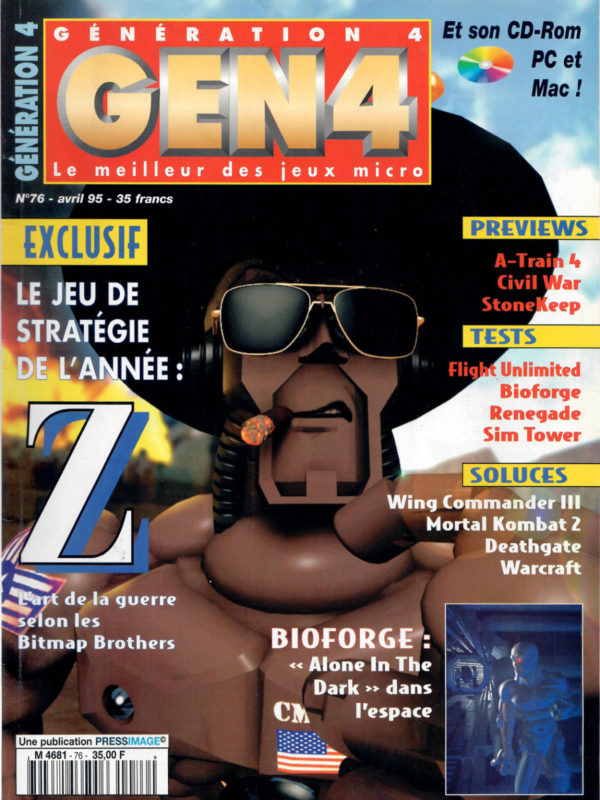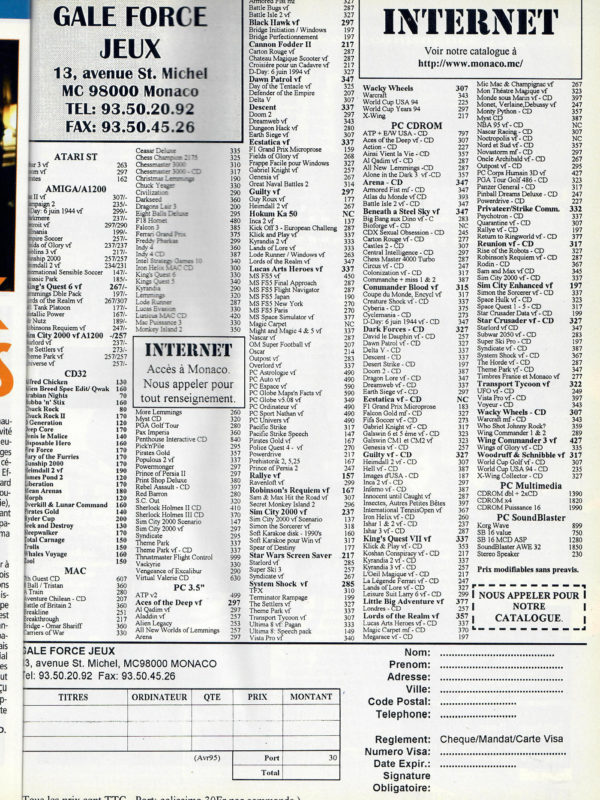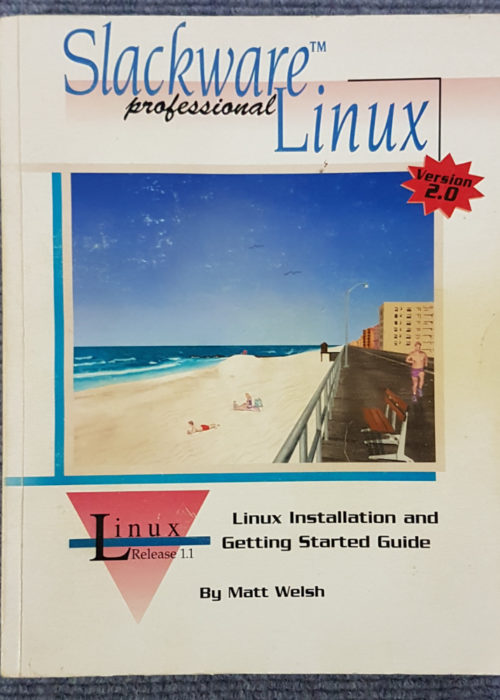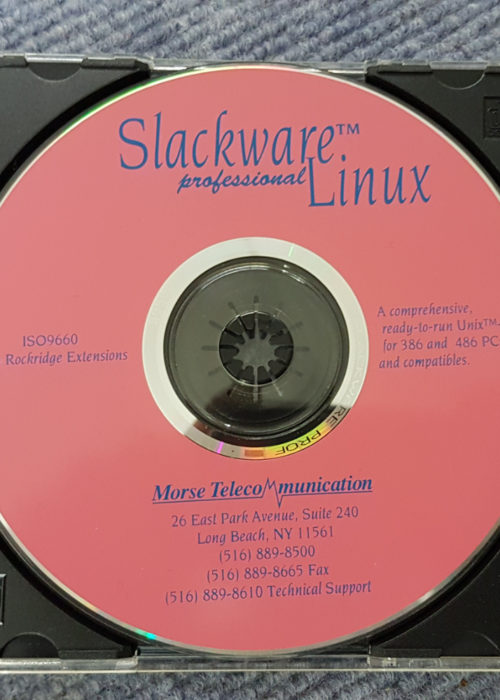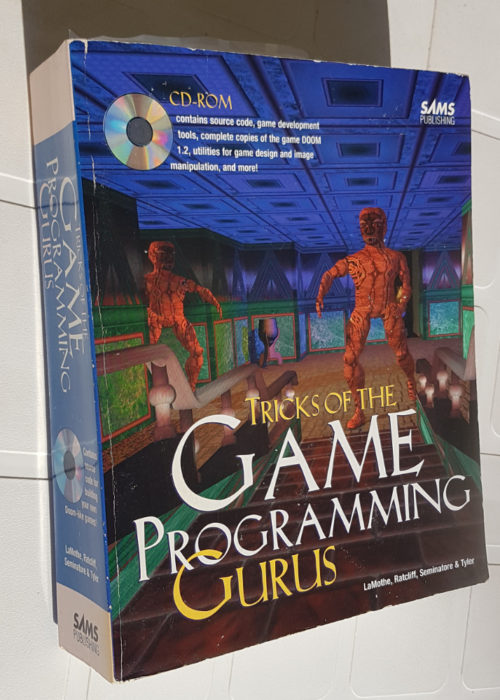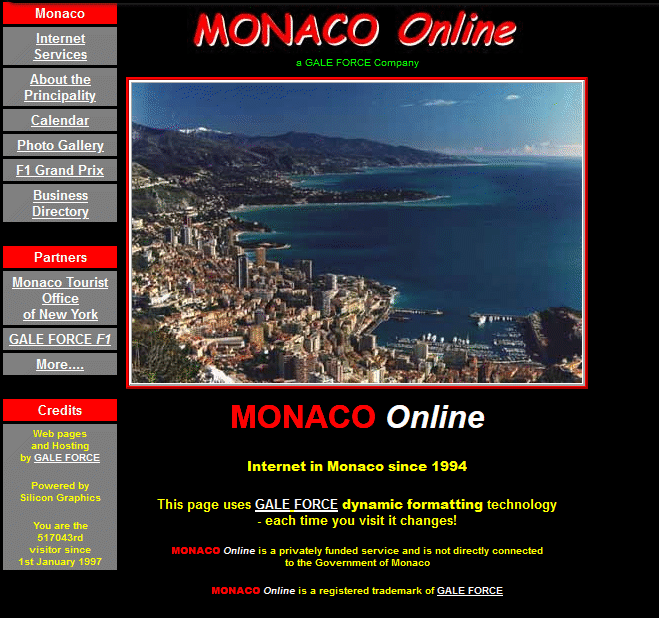
This is the true story of how, in 1994, I made monaco.mc and brought public Internet to Monaco and the South of France. I am writing this during the Covid lockdown of 2020. The Internet and all that comes with it is now indispensable. It’s quite hard to remember a time when it did not exist. Let’s try. . . .
A Time Before
In 1994 telephones stayed on desks and were cabled to wall sockets. Televisions collected their handful of channels from an aerial on the roof. There were no digital cameras. Photographs were taken on plastic film which then had to be chemically developed and printed in a Lab. To use on a PC these printed photos then had to be scanned into a computer. We thought computers were really advanced, we had the mouse and Windows although most business programs (now Apps!) and games were based on the non graphical MS-DOS. FAX was the standard method for business communications having recently driven out Telex.
Amazon.com was actually created in July 1994 but, of course, I didn’t know that yet as I had never heard of the Internet.
May the Force be with You !
GALE FORCE Computing
For 6 years my wife, Penny, and I had been running a software development and IT support business in Monaco named GALE FORCE Computing. We had a shop and 3 employees. The employees handled most of the onsite support, Penny managed the paper work while I wrote bespoke financial and CRM software for local clients while dreaming up new projects. Over the years I had pushed the business into several areas that had taken my interest.
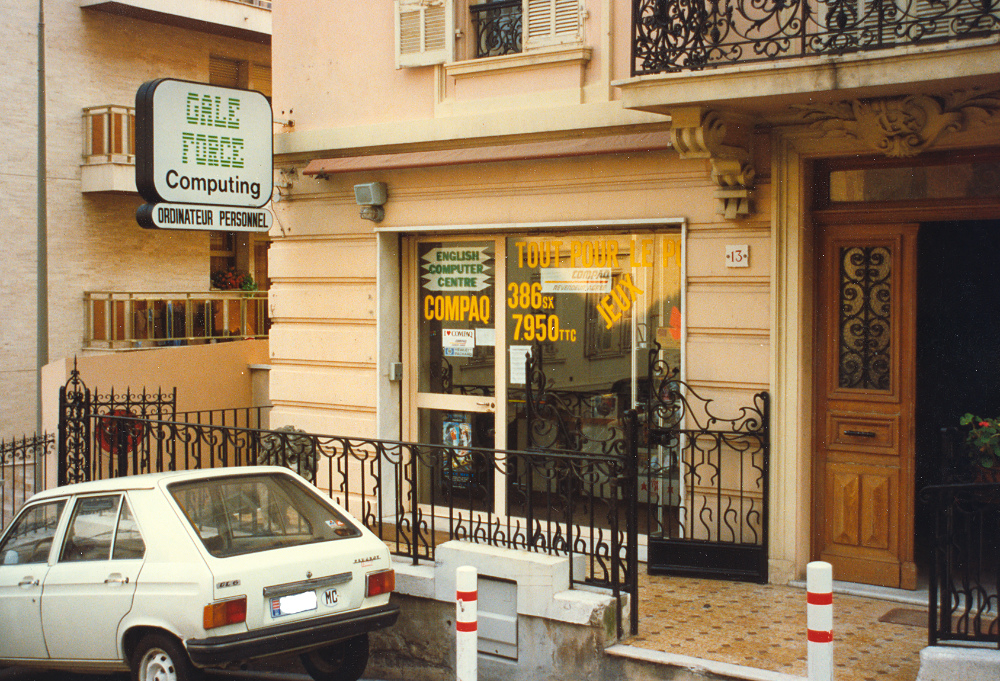
Early on we had tried our hand at Laser Cartridge recharging. In the days of the HP Laser Jet I and II the cartridges were really expensive so I signed up with a company in the USA which provided the parts and know how for us to rebuild the cartridges in Monaco. Until the cartridge prices came down this was a really successful business. Its true legacy however was the way it opened many doors into new clients. As our recharging was totally unique in the area we were soon working with many companies both in Monaco and the surrounding area especially the business park in Sophia Antipolis. Many of these Laser Recharge clients also took advantage of our other services such as bespoke software and onsite IT support services.
For a while we were also in the specialised Yacht IT arena. The initial products were PC Maritime based navigation systems which for the first time ever allowed the Captain to see their position on a live map by linking a PC to the ship’s GPS. One year (1992 I think) we had a stand at the Monaco Yacht Show and the Cannes Yachting Festival. We became involved in many unique installations such as building a massive CRT screen into a 50m yacht’s bridge and distributing the mapping screen to the guest cabins. All standard stuff these days.

Cannes Yacht Show 1993
Another offshoot was games mail order. For several years our GALE FORCE Jeux (Jeux = Games in French) operation was one of the top 3 computer games mail order companies in France. When I discovered that one of our major IT parts suppliers could also supply games for Atari, PC, Mac etc I saw this as a mail order business opportunity. We ran full page adverts in all the French Games magazines and were quickly selling hundreds of games each week. Massive turnover, low profits.
Actually in 1995 I made a website for GALE FORCE Jeux with photos of all the games and ordering details. This could have been the very first online retailer in France.
Apart from these ideas that became operational I also seriously looked into building a Computer Animation Effects and Movie Studio with people I met at the annual Imagina Conference in Monaco (Pixar’s Toy Story came out in 1995). I met with a UK company called W Industries with a plan to become involved with their Virtuality Virtual Reality product line. I also made a business plan for my Monaco Roller Coaster project which combined Virtual Reality with a physical motion platform to create the simulation of a Roller Coaster over the port and rock of Monaco. I visited the area that is now FNAC in the Metropole Gallery when it was just concrete dust as a potential space for the system. So, as you can see, I was certainly open to new ideas.
In the real world my core business revolved around clients based in Monaco, mostly small offices with a few PC’s. Some were larger with 20 or 30 staff and PC’s usually networked internally to servers with tape backups. Typically we were installing Microsoft Windows 3 and either Novell Netware or Microsoft Windows NT on the server. Communications between offices was done by phone and FAX. Email as such did not exist.
A couple of our larger clients had multiple sites and needed proper inter office data communications. Since 1993 we had been installing a system called Microsoft Mail. MS Mail was a private direct dial Email system. In each client office we installed an MS Mail server with a modem that connected to a normal phone line. Like today each user PC then had a mail program which allowed them to create messages to send to other users in the company. The mail program sent the message to the local server which knew the phone number of the office server the destination user was in. The server then just dialed the other server’s number and transferred the message. In some cases this involved international phone calls so was not so cheap especially as the data rate was really slow so the calls could be quite long.
Like all data over phone line systems the MS Mail servers used devices called Modems (Modulator Demodulator) to call each other. The modem connected the server to a normal voice phone line and allowed it to call other modems. Once the remote modem answered they would talk to each other using a sequence of audible tones as of course they were using voice grade phone lines. The synchronizing tones when the remote modem answered became a thing of beauty to us technical guys.
As the modems were sending the data in the form of audible tones the actual rate of data transfer was amazingly slow. The first modems we used were capable of transferring 300 bits of data per second which equates to about 30 characters or 0.00003 Mega bytes. By 1994 new technology had increased the speed to a whopping 9,600 bits per second (960 character per second, 0.00096 Megabytes per second). Faster speeds were reducing the call times, but this was still an expensive proposition especially between countries.
Something new this way comes !
In 1994 I kept up to date mostly by reading magazines and books. Added to this we received lots of product brochures through the post as we were agreed resellers for many companies, including Microsoft, HP, Toshiba and Compaq. One of my other inputs at the time could be called “news from travelers”. Monaco is a very international country so many of our clients were tripping around the world or had offices in other countries. During my normal Onsite Tech Support role I often discussed new technical developments with clients always looking for new opportunities. In the autumn of 94 I started to hear about this new public email system that didn’t need MS Mail and special servers. I needed to investigate, but where to begin ?
After some magazine research I determined that this public email system was based on an inter net which as far as I could see was a commercial extension of an educational network that linked International Universities and Research centers. But how on earth could I link to that from Monaco?
I first talked with the local Monaco phone company, the Office Monegasque de Telephones (OMT), but they had never heard of it. They suggested we try a new high tech Government communication initiative called the Monaco Teleport. Nope they didn’t know either. Their big thing was another new technology called ISDN, a system of digital phone lines they were just starting to offer to local companies. Each ISDN line provided two 64k digital channels which, at the time, were being marketed for good quality voice and fax services.
Somehow I managed to contact the correct people at the French educational network in Paris. They were ready to sell me an access, but it would be in Paris. OK. Next step was to talk with France Telecom in Nice and ask how much a permanent digital line from Paris to Monaco would cost. I already knew these FT guys a little as previously I had investigated the possibility of building a Minitel server.
A little side note: Minitel was fascinating. In the 1980’s France Telecom had decided to do away with phonebooks and instead give everyone a free little computer terminal with a character based CRT display and small keyboard. It plugged directly into the phone line with a built in 1200 bits per second modem. France Telecom built a nationwide server system which users could dial and use the Minitel to find phone numbers and other information. Interestingly they sold access to this system to 3rd party data providers. This resulted in companies all over France setting up Minitel servers to provide everything from online shopping to news and sports reports. The killer was that the data provider could charge for the information with the costs being simply added to the user’s normal phone bill, no credit card required. (Eat your heart out Internet !) At the time I was looking at developing online Minitel games. Imagine having an online server for games that made money as people played.
Anyhow back to the story: At our meeting France Telecom Nice told us not to try to link to Paris but to wait until December 94 when their digital communications arm, Transpac, would start selling internet access via a new node they were building along the coast from us in Marseilles.
It was now November 94 and we had our link planned. Now I needed a plan for what to do with it. I needed more books.
London Calling
In those days if you wanted books you went to a book store. Of course book stores didn’t have a vast amount in stock so often that meant reviewing catalogues, ordering what seemed interesting then waiting for them to arrive. As luck would have it British Airways were advertising a “Christmas shopping trip to London” on our local radio station. This included return flights between Nice and London, transport into London and a few nights in a hotel near the centre. I signed up and went in search of a real bookshop.
Once in London I was told Foyles was the place to go on Charing Cross Road. I was in heaven in the computer section. Never in my life had I seen so many seriously technical books about all aspects of my hobby. The first time in I bought some general Internet books then went back to the hotel to try to work out what I was getting myself into. Very quickly it became clear that building my own internet email system was not going to be simple. In today’s terms I was planning to design, build and operate my own Data Center and Internet Access Point.
Luckily, before I started my own business I was working in a Monaco based international mini computer technical support company. The multi user systems we were supporting were about the size of a fridge freezer and importantly their operating system was based upon a variation of AT&T’s System V Unix which I now knew like the back of my hand. Much of what I was reading in my new books was familiar from these Unix days.
It seemed I was going to need to build a domain, an email storage and retrieval system, an email sending server and possibly a World Wide Web server. In order for people to collect their email they would have to connect to my network, this would involve phone lines, modems, a TCP/IP network protocol server and an authentication system so I could control and charge for access. The next day I was back in Foyles to buy books which detailed each one of these functions. These included several books about something called Linux which looked really interesting – more later.
As a side note I also bought a brilliant book (which I still have) about designing the new First Person Shooter games that had just appeared on MS-DOS. Remember Doom from Id Software?
I had gone to London with pretty much an empty suitcase. It came back weighing a ton as it was full of books. I seem to remember spending over 500 pounds sterling on books during that trip. Honestly I don’t think I actually did any Christmas shopping, although I probably bought plenty of Toblerone at the airport for the kids.
Let’s Do This
After much reading on the plane and over the next few days I decided this was definitely an opportunity. I went back over the Transpac application form and duly signed up for the fastest line possible. At the time I was a little concerned that 19.2kbs (or 0.0192 Mega bits per second) didn’t sound very fast, but there again what did I know.
Financially this was going to be a leap of faith. Just the line would cost 10,000 French Francs (about 1,500 Euros) to install then 8,000 French Francs (about 1,200 Euros) per month. This was going to be quite a weight if it didn’t sell. I made my case to our finance department, Penny, and it was accepted.
Apart from ticking the fastest speed, the other important item on the application form was my requested Domain Name. Luckily I had a book about this so at least I knew what a domain name was. I also knew that the Top Level Domain (TLD) for Monaco was .mc. On the application form it only showed fr. I didn’t really think just crossing out the fr and putting mc was going to work but that’s what I did. On the grounds of thinking big I applied for monaco.mc.
As expected a few days later we had a FAX, remember those, from Transpac saying that we could have monaco.fr as .mc did not exist. Instantly I complained and pointed out that we were in Monaco not France. I included a FAX of the page from my Internet book that listed all the ICANN TLD’s for countries and quite clearly showed that Monaco was .mc. I don’t really remember exactly what happened next, but I think I signed some papers to say that I agreed that France Telecom could operate the .mc TLD for Monaco.
Looking back on it now this was absolutely massive. I had just created a country code. I’m not sure who Transpac thought I was but they happily played ball and configured their TLD names servers to answer to both .fr and .mc just for me. Awesome.
So with the paperwork out of the way I had about a month to work out what I needed to build. There was no pressure as no one else knew what I was doing so I just fitted the design work around my normal long days in the office.
I knew I was effectively going to be operating 3 distinct functions on this network: Email, Internet Access and Domain Name Services (DNS). So I figured I would need 3 PC’s. This quickly turned into 5 PC’s when I realised that the DNS needed 2 PC’s (Main and Backup) as did the email (In and Out).
I didn’t think it was sensible to buy anything at this stage so I cobbled together a collection of old 486 and Pentium PCs that I had lying around. As well as selling Compaq and Toshiba PC’s we also built and sold our own units from standard parts so we always had plenty of bits and old PC’s around.
For our clients to dial-in I ordered two phone lines from OMT that would both ring on the same number. I tried to have a special deal as they were going to be dial-in only numbers but no one really seemed to understand so nothing came of that.
All the lines were now ordered and I had a stack of books and hardware to play with. It was going to be a couple of weeks before the main line arrived so no pressure. As I said we had not announced anything, there were no competitors for the service and I didn’t actually know if anyone wanted it or if I could get it all to work anyway.
Normally in those days everything we did with PC’s was based on Windows 3 or NT. These of course cost money. While in Foyles I had bought a couple of books about a free operating system called Linux. Each book helpfully included a CD with the Linux on it – for free! I had no idea if this Linux would be reliable on my hardware but as it was free I decided to give it a go. It turned out that Linux was almost identical to the AT&T Unix I was already an expert in so the learning curve was tiny.
I soon had a couple of Linux PC’s on my own private network then my two incoming phone lines arrived. This was to be the first challenge. How to dial-in from home and connect to the network.
I connected the two phone lines to two 9600 baud modems which connected to the two COM ports on a 486 PC running Linux. The ports were configured as dial-in users and the modems set to auto answer any calls. From home I could call in using my Windows 3.1 PC, modem and a terminal program. Using this configuration I could login to the Linux PC as a user. Fine for remote working in a command line environment but little else.
The next step was to make the link be a type of network bridge. I wanted my Windows PC to dial in to the Linux PC then use the network port on Linux for the networking on Windows. Easier said than done.
The solution was dial-in networking software which had to be installed on Windows 3.1. I guess this must have either come from a magazine/book or a Microsoft CD as remember at this time I had no access to the Internet. So by using this software and a few tricks on Linux I had the dial-in networking working. This meant I could now use telnet on Windows to login to any of the Linux PC’s on my network. Whoopee !
We had a very Merry Family Christmas 1994 during which I did very little further work on the Internet project. This was our last Christmas without Internet. . . . .

